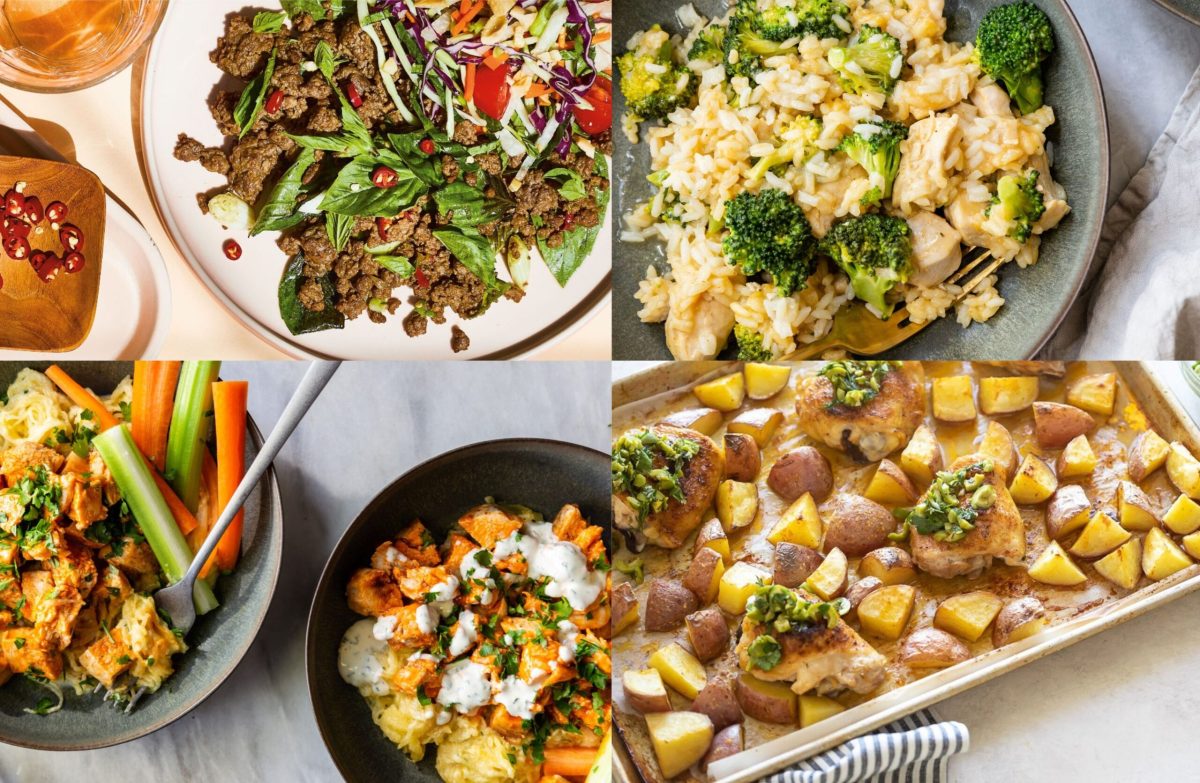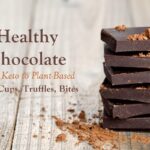Conquer busy weeknights with a vibrant collection of dairy-free freezer meals! This guide unveils five delicious, nutritionally balanced recipes designed for speed and convenience. Imagine effortlessly transitioning from a hectic workday to a wholesome, flavorful dinner, all thanks to the power of meal prepping and smart freezer storage. We’ll walk you through each step, from selecting the perfect dairy-free substitutes to mastering the art of freezing and reheating, ensuring your meals retain their delicious texture and taste. Prepare to transform your weeknight routine into a stress-free culinary adventure.
We’ll explore a range of flavorful options, offering detailed ingredient lists, nutritional information, and stunning visuals to inspire your culinary creativity. Learn how to adapt your favorite recipes to be completely dairy-free, and discover ingenious techniques for maximizing freezer space and preventing freezer burn. This comprehensive guide equips you with the knowledge and confidence to create a freezer full of healthy, delicious, and time-saving meals.
Step-by-Step Guide
Creating dairy-free freezer meals is a fantastic way to streamline weeknight dinners and ensure you always have healthy, delicious options on hand. This guide will walk you through the process, from prepping ingredients to reheating your culinary creations. By following these steps, you can effortlessly build a freezer stash of nutritious meals, saving you both time and stress.
Meal Planning and Preparation
Effective meal planning is crucial for efficient freezer meal preparation. Begin by selecting dairy-free recipes that freeze well; hearty stews, chili, and vegetable-packed curries are excellent choices. Consider your family’s preferences and dietary needs when making your selections. Next, gather all your ingredients, ensuring they are fresh and of high quality. Thorough preparation, including chopping vegetables and measuring spices, will significantly speed up the cooking process. Imagine a vibrant scene: a neatly organized countertop, brimming with colorful vegetables, fragrant spices, and meticulously measured ingredients, ready to be transformed into delicious, dairy-free meals.
Cooking and Portioning
Once your ingredients are prepped, follow your chosen recipe instructions carefully. Cook the meal completely, ensuring it’s thoroughly heated to eliminate any potential bacteria. Allow the meal to cool completely before freezing. This prevents the formation of ice crystals which can negatively affect the texture of your meal. Next, portion the meal into individual or family-sized containers. Using consistent portion sizes ensures balanced meals and minimizes waste. Picture this: perfectly portioned containers, each filled with a hearty, vibrant stew, ready for quick and easy reheating.
Packaging for Freezing
Proper packaging is key to preventing freezer burn and maintaining the quality of your meals. Use airtight, freezer-safe containers or heavy-duty freezer bags, removing as much air as possible before sealing. Label each container clearly with the meal name and the date it was frozen. This helps with organization and prevents accidental consumption of outdated meals. Imagine rows of clearly labeled containers, each a testament to your efficient meal-prep strategy, neatly organized in your freezer, ready for action.
Optimizing Freezer Space
Efficient freezer organization maximizes space and allows for easy retrieval of meals. Consider using freezer-safe baskets or dividers to create distinct sections for different meal types. Flattening containers allows for more efficient stacking, maximizing vertical space. A well-organized freezer is a beautiful sight: stacks of containers, neatly arranged, easily accessible, reflecting a sense of order and preparedness.
Preventing Freezer Burn
Freezer burn, characterized by discoloration and a dry, leathery texture, occurs when food is exposed to air. To minimize freezer burn, ensure your containers are completely airtight and leave minimal headspace. For extra protection, wrap the containers in an additional layer of plastic wrap or aluminum foil before placing them in the freezer. This creates an additional barrier against air exposure, preserving the quality of your meals.
Reheating Dairy-Free Freezer Meals
There are several methods for reheating frozen dairy-free meals, each impacting texture and taste. For even heating, thawing in the refrigerator overnight is recommended before reheating in a saucepan on the stovetop. This method preserves the texture and flavor best. Alternatively, you can reheat the meal directly from frozen in the microwave, though this may result in a slightly less consistent texture. Another option is using the oven, which is ideal for dishes that benefit from a crispier texture, like roasted vegetables. Each method offers a unique approach, allowing you to tailor the reheating process to your preferences and the specific meal.
Dairy-Free Ingredient Substitutions

Embarking on a dairy-free culinary journey doesn’t mean sacrificing flavor or texture. Many delicious and nutritious dairy-free alternatives exist, allowing you to easily adapt your favorite weeknight recipes and create satisfying, creamy, and cheesy dishes without the dairy. This section explores common dairy ingredients and their suitable replacements, highlighting their nutritional profiles and culinary applications.
Dairy-free cooking opens up a world of exciting possibilities, transforming familiar dishes into vibrant and healthy meals. Understanding the properties of different dairy-free alternatives is key to achieving the desired consistency and taste in your recipes. Let’s delve into the specifics of effective substitutions.
Milk Substitutions
Cow’s milk, a staple in many recipes, provides moisture, richness, and often contributes to a creamy texture. Fortunately, numerous plant-based alternatives offer similar functionalities. Soy milk, almond milk, oat milk, coconut milk, and rice milk are popular choices, each with its own unique flavor profile and nutritional composition. Soy milk, for example, is a complete protein source, while almond milk is lower in calories and fat. Oat milk offers a creamy texture ideal for smoothies and baking, while coconut milk lends a rich, tropical flavor to curries and desserts. Rice milk, though less nutritious, provides a neutral flavor suitable for those sensitive to other plant-based milks. The choice often depends on personal preference and the specific recipe’s requirements.
Cheese Substitutions
Cheese, a beloved ingredient in countless dishes, adds savory flavor and a delightful melt. Dairy-free cheese alternatives range from nutritional yeast, which offers a cheesy, nutty flavor and is often used as a topping for pasta or popcorn, to various commercially available vegan cheeses made from nuts, soy, or tofu. These vegan cheeses vary in texture and flavor, some mimicking the melt of traditional cheese while others offer a firmer, crumbly consistency. Nutritional yeast provides a good source of B vitamins, while many vegan cheeses are fortified with calcium and vitamin D. However, it’s important to check nutritional labels as the nutritional content can vary significantly between brands and types.
Cream Substitutions
Cream, whether heavy cream or light cream, contributes richness and creaminess to sauces, soups, and desserts. Coconut cream, a thick, creamy extract from coconut milk, is an excellent dairy-free substitute, providing a rich, slightly sweet flavor. Cashew cream, made by blending soaked cashews with water, creates a wonderfully smooth and creamy texture, ideal for sauces and dips. Other options include silken tofu, which can be blended to create a creamy base for various dishes, and full-fat coconut milk, which offers a similar richness but may have a more pronounced coconut flavor. Each alternative offers a unique texture and taste, making it essential to consider the specific recipe’s flavor profile when selecting a substitution.
Frequently Used Dairy-Free Ingredients and Their Applications
Understanding the versatility of dairy-free ingredients is crucial for successful recipe adaptation. The following list showcases common options and their diverse applications:
- Coconut Milk: Curries, soups, sauces, desserts, smoothies.
- Almond Milk: Baking, smoothies, coffee creamer, cereal.
- Oat Milk: Smoothies, baking, coffee creamer, oatmeal.
- Soy Milk: Baking, smoothies, cooking, tofu production.
- Nutritional Yeast: Pasta topping, popcorn seasoning, sauces, dips.
- Cashews (soaked): Creams, sauces, dips, vegan cheese.
- Silken Tofu: Smoothies, sauces, dips, desserts.
Adapting Existing Recipes for Dairy-Free Diets
Transforming beloved weeknight meals into dairy-free delights is simpler than you might think. Many recipes can be easily adapted with the right substitutions, preserving both flavor and texture. This section will guide you through modifying three popular recipes, highlighting the rationale behind each dairy-free swap.
Dairy-Free Mac and Cheese
This creamy classic gets a dairy-free makeover using a simple substitution that maintains its rich, cheesy goodness.
| Original Recipe | Dairy-Free Version |
|---|---|
|
Ingredients: 1 pound elbow macaroni 1/2 cup butter 1/2 cup all-purpose flour 3 cups milk 1 teaspoon salt 1/2 teaspoon black pepper 4 cups shredded cheddar cheese |
Ingredients: 1 pound elbow macaroni 1/4 cup nutritional yeast 1/4 cup vegan butter 1/4 cup all-purpose flour 3 cups unsweetened plant-based milk (almond, soy, or oat) 1 teaspoon salt 1/2 teaspoon black pepper 2 cups shredded dairy-free cheddar cheese (brands like Daiya or Violife) |
|
Instructions: Cook macaroni according to package directions. Melt butter in a saucepan, whisk in flour, and gradually whisk in milk until smooth. Stir in salt, pepper, and cheese until melted and creamy. Toss with macaroni. |
Instructions: Cook macaroni according to package directions. Melt vegan butter in a saucepan, whisk in flour, and gradually whisk in plant-based milk until smooth. Stir in nutritional yeast, salt, pepper, and dairy-free cheese until melted and creamy. Toss with macaroni. |
The rationale behind this substitution lies in replacing the dairy butter and milk with vegan alternatives and using nutritional yeast for a cheesy flavor boost. Nutritional yeast adds a savory, umami note similar to parmesan cheese. Potential challenges include finding a dairy-free cheese that melts smoothly; experimentation with different brands might be necessary.
Creamy Tomato Soup
This comforting soup benefits from a simple swap that maintains its velvety texture.
| Original Recipe | Dairy-Free Version |
|---|---|
|
Ingredients: 1 tablespoon olive oil 1 onion, chopped 2 cloves garlic, minced 28 ounces canned crushed tomatoes 4 cups chicken broth 1 cup heavy cream Salt and pepper to taste |
Ingredients: 1 tablespoon olive oil 1 onion, chopped 2 cloves garlic, minced 28 ounces canned crushed tomatoes 4 cups vegetable broth 1 cup full-fat coconut milk Salt and pepper to taste |
|
Instructions: Sauté onion and garlic in olive oil. Add tomatoes and broth; simmer for 20 minutes. Stir in heavy cream; season with salt and pepper. |
Instructions: Sauté onion and garlic in olive oil. Add tomatoes and broth; simmer for 20 minutes. Stir in coconut milk; season with salt and pepper. |
Here, heavy cream is replaced with full-fat coconut milk, providing a similar creamy consistency without the dairy. The coconut flavor is subtle in this recipe, blending well with the tomatoes and broth. If a stronger coconut taste is a concern, using a lighter coconut milk alternative may be preferable.
Chicken Alfredo
This classic pasta dish is transformed using a simple cashew-based sauce that mimics the richness of a traditional Alfredo sauce.
| Original Recipe | Dairy-Free Version |
|---|---|
|
Ingredients: 1 pound fettuccine 1 cup butter 2 cups heavy cream 1 cup grated Parmesan cheese Salt and pepper to taste Cooked chicken |
Ingredients: 1 pound fettuccine 1 cup raw cashews (soaked in hot water for at least 30 minutes) 1 cup vegetable broth 2 tablespoons nutritional yeast Salt and pepper to taste Cooked chicken |
|
Instructions: Cook pasta. Melt butter in a saucepan, whisk in cream and Parmesan until smooth and creamy. Toss with pasta and chicken. |
Instructions: Cook pasta. Blend soaked cashews, vegetable broth, and nutritional yeast until completely smooth. Season with salt and pepper. Toss with pasta and chicken. |
The creamy texture and richness of a traditional Alfredo sauce is replicated here using a simple cashew cream base. Soaking the cashews is crucial for a smooth, creamy texture. Nutritional yeast enhances the cheesy flavor. The biggest challenge might be achieving the desired consistency; adjusting the amount of broth might be necessary depending on the cashew cream’s thickness.
Unlock the secret to effortless weeknight dinners with our comprehensive guide to dairy-free freezer meals. By mastering the techniques and recipes presented here, you’ll not only save precious time and energy but also enjoy a diverse array of flavorful and healthy meals. Imagine the satisfaction of knowing that a delicious, nutritious dinner awaits, ready in minutes, even on the busiest of evenings. Embrace the convenience and embark on a culinary journey that simplifies your life without compromising on taste or nutrition. Start planning your stress-free weeknights today!
Question Bank
Can I freeze dairy-free meals for longer than a month?
While most dairy-free freezer meals are safe for up to 3 months, it’s best to prioritize using them within 2 months for optimal flavor and texture.
What’s the best way to thaw a frozen dairy-free meal?
The safest method is to thaw your meal overnight in the refrigerator. You can also thaw it in a microwave using the defrost setting.
Can I reuse containers after freezing dairy-free meals?
Yes, provided they are thoroughly cleaned and sanitized after each use. Avoid using containers that have been damaged or show signs of wear.
Are all dairy-free substitutes nutritionally equivalent to their dairy counterparts?
No, nutritional content varies. Some dairy-free substitutes may be higher in certain nutrients, while others may be lower. Always check the nutritional information.


